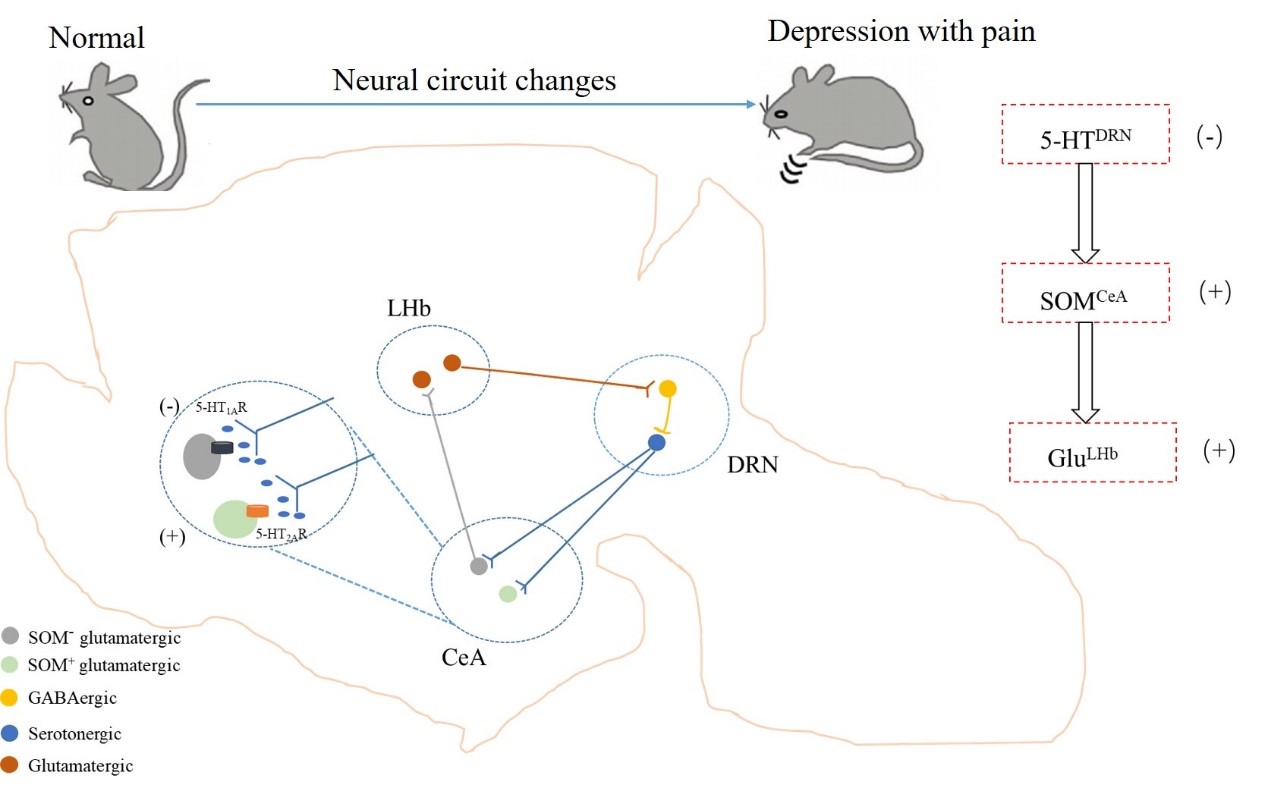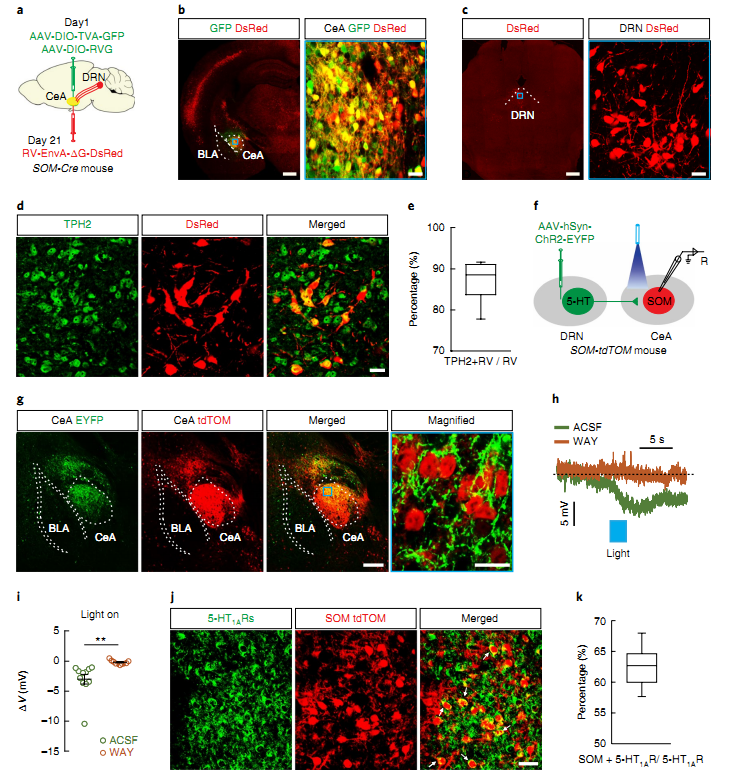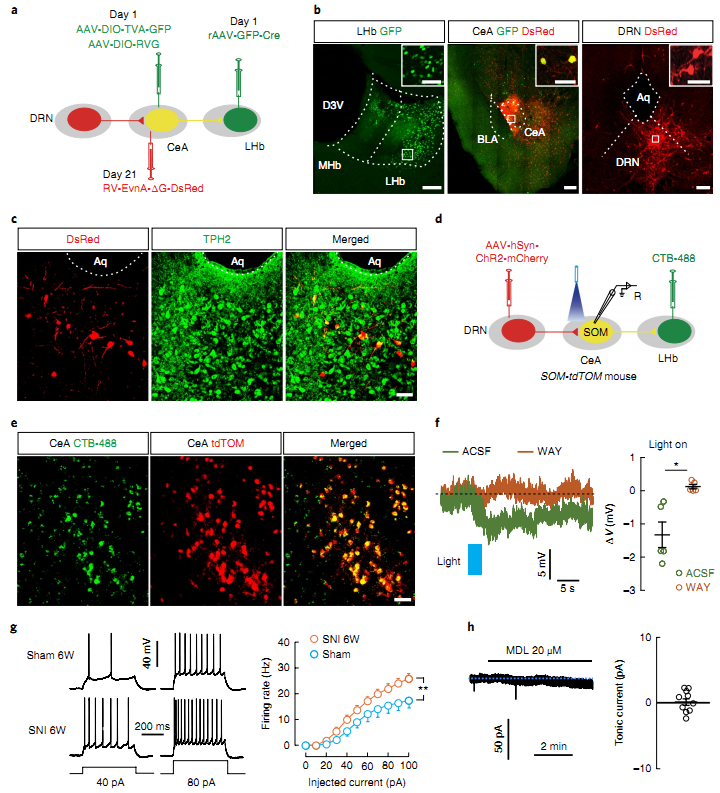Chronic pain, such as neuropathic pain, cancer pain, migraine and chronic low back pain, is one of the most common clinical symptoms. Patients with chronic pain often have the clinical symptoms of depression. Moreover, depressive symptoms may lead to an excessive duration and intensity of pain. This tends to create a cycle of pain and depressive symptoms. Although comorbid depressive symptoms (CDS) in chronic pain
is a common health problem, the neural circuit mechanisms underlying these symptoms remain unclear. So exploring the neural circuit mechanisms and finding an effective treatment for CDS in chronic pain is a major challenge in the field.
Combining viral tracing, electrophysiological, optogenetic and chemogenetic methods, Zhou
et al. dissected the functional organization of the DRN→CeA circuit and explored the principle of this circuit adaptation in a male mouse model of chronic pain. Finally, they proposed a 5-HT
DRN→SOM
CeA→lateral habenula circuit, which is critical for manifesting CDS. And the research results entitled
A neural circuit for comorbid depressive symptoms in chronic pain was published in this issue of
Nature Neuroscience.
Graphical Abstract

The amygdaloid complex is well-known to be relevant to fear learning, anxiety and pain. The central nucleus of the amygdala (CeA) serves as the main out-put nucleus for amygdala functions. In addition, the CeA forms widespread connections with forebrain areas and the brainstem, which have been implicated in mediating fear and mood disorders. These studies suggested that the CeA is a probable convergent point of chronic pain and depression. Then how does CeA play the bridge role in comorbid depressive symptoms (CDS) in chronic pain? In this research, they used GABA neurons in CeA as targets to analyze the neural circuits of comorbid depressive symptoms (CDS) in chronic pain.
An inhibitory pathway from 5-HTDRN to SOMCeA mediated by 5-HT1ARs.
First, they examined the incoming projections onto the CeA GABAergic neurons by using Cre-dependent retrograde trans-monosynaptic tracing viruses (From
BrainVTA) and found that DRN neurons innervated CeA GABAergic neurons. To identify the subtypes of CeA neuron innervated by DRN, they focused on three distinct types of GABAergic interneuron by Cre-dependent retrograde trans-monosynaptic tracing viruses.Finally they found that 5-HT
DRN neurons send monosynaptic projections to SOM
CeA neurons.
 Fig.1
Fig.1 |
5-HTDRN innervated SOMCeA by 5-HT1ARs.
LHb is the output of the 5-HTDRN→SOMCeA circuit for depressive-like behavior in mice with chronic pain.
But how do the SOM
CeA neurons induce in comorbid depressive symptoms (CDS) in chronic pain? They studied the long-term projection fibers of SOM
CeA neuron and observed an extremely large number of the mCherry
+ fibers in the lateral habenula (LHb) when injected AAV-DIO-ChR2-mCherry into CeA of SOM-Cre mice. Combining Cre-dependent retrograde trans-monosynaptic tracing viruses and double immunostaining, they suggested that SOM
CeA neurons mainly send glutamatergic projections onto the Glu
LHb neurons, and the resulting activation of LHb neurons induce depression symptoms. To characterize the connectivity of the 5-HT
DRN→SOM
CeA→Glu
LHb circuit, further verification was made by the researchers.
 Fig.2
Fig.2 |
Dissection of the 5-HTDRN→SoMceA→GluLHb circuit.
Conclusion
Combining neuronal tracing, pharmacological and optogenetic stimulation
(From
BrainVTA), Zhou et al. identified a neural circuit for comorbid depressive symptoms in chronic pain. In the chronic pain state, the activity of 5-HT
DRN neurons projected to CeA was decreased, which led to the de-inhibitory activation of SOM
CeA, enhancing the excitatory projection of SOM
CeA neurons to LHb, and inducing depression-like behaviors in mice. At the same time, this research provides ideas and potential targets for the treatment of chronic pain-induced depression.
The viruses used in this article from BrainVTA are in the table below
|
RV |
R01002 RV-ENVA-ΔG-DsRed |
|
Tracing Helper |
PT-0062 rAAV2/9-Ef1α-DIO-EGFP-2a-TVA
PT-0023 rAAV2/9-Ef1α-DIO-RVG |
|
Optogenetic |
PT-0002 rAAV2/9-Ef1α-DIO-hChR2 (H134R)-mCherry
PT-1317 rAAV2/9-hSyn-hChR2-EYFP
PT-0150 rAAV2/9-hSyn-hChR2-mCherry
PT-0003 rAAV2/9-Ef1α-DIO-eNpHR3.0-EYFP |
|
Chemogenetics |
PT-0042 rAAV2/9-Ef1α-DIO-hM3D(Gq)-mCherry
PT-0043 rAAV2/9-Ef1α-DIO-hM4D(Gi)-mCherry |
|
Control |
PT-0013 rAAV2/8-Ef1α-DIO-mCherry
PT-0012 rAAV2/9-DIO-EYFP |
Read the paper
A neural circuit for comorbid depressive symptoms in chronic pain
If you have any questions just email us at
sales@brainvta.com or click the
Send Request button.


